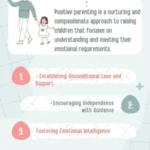In the intricate dance of parenting, each moment poses unique challenges, and navigating them requires finesse. The tale begins with a hungry puppy, a spirited child, and a lesson in positive parenting.
The Scenario Unfolded
In the midst of a regular evening, the puppy, having attended her first “puppy class,” exhibited an extraordinary hunger. Anticipating her enthusiasm, the bowl was placed down, a scene set for a harmonious meal. However, the unexpected entry of a boisterous child, engrossed in the cacophony of his toy truck, disrupted the tranquil ambiance. Startled, the puppy gulped her food, a moment etched in the memory of a well-intentioned but tired mother.
The Imperfect Nature of Parenting
Even armed with a degree in child development and a wealth of knowledge, the mother found herself succumbing to the strains of fatigue and stress. The incident unfolded not as a testament to perfection but as a reminder that, in parenting, imperfections are inevitable. Acknowledging this reality becomes paramount in the pursuit of effective and compassionate parenting.
Introducing the 3-Step Guide to Positive Parenting
Step One: Acknowledge Your Child’s Feelings
Positive parenting, encapsulated in a powerful 3-step guide, begins with acknowledging the child’s emotions. Understanding that behavior is a form of communication, parents are encouraged to get eye-level with their child and inquire about their feelings. By naming the emotion and empathizing with the child’s experience, a foundation for emotional intelligence and regulation is laid.
Step Two: Physically Connect to Diffuse Emotions
Following the acknowledgment of feelings, the guide advocates for a physical connection with the child. This step aims to provide a tangible outlet for emotions, creating an environment where acceptance prevails. By reassuring the child that their emotions are understood and accepted, parents set the stage for cooperation and effective communication.
Step Three: Teach Positive Behavior and Emotional Expression
With emotions acknowledged and a connection established, the final step involves teaching positive behavior and healthy ways to express emotions. Drawing on the original meaning of discipline as “teaching” and “learning,” positive parenting positions parents as guides. By empowering children with the tools to navigate their emotions and interact positively with others, this step fosters long-term behavioral change.
Implementing the A.C.T. Method in Real-Life Scenarios
Responding to Playtime Challenges
Imagine a scenario where a child is attempting to elicit a reaction from the puppy using a toy truck. The A.C.T. method seamlessly comes into play. Acknowledge the child’s feelings by stating, “I see you are trying to get a reaction from the puppy. Are you wanting to play with her?” Follow this with a physical connection, perhaps a reassuring touch, and then proceed to teach by suggesting alternative ways to engage with the puppy positively.
Addressing Playground Behavior
When a child displays rough behavior on the playground, the A.C.T. method guides parents in responding effectively. Acknowledge the child’s frustration, connect through physical gestures like a hug, and then teach by offering alternative ways to release frustration without resorting to negative actions.
Dealing with Departure Dilemmas
As a child expresses sadness about leaving a place, the A.C.T. method facilitates a seamless response. Acknowledge the child’s emotions, connect through a comforting hug, and then teach by discussing ways to handle similar situations in the future. This integrated approach empowers the child to navigate emotions constructively.
The Power of Acknowledge, Connect, and Teach
In the whirlwind of parenting, the A.C.T. method emerges as a beacon of guidance. Acknowledging the child’s emotions, establishing a physical connection, and imparting essential lessons create a harmonious cycle that nurtures emotional intelligence and positive behavior.
Why A.C.T. Works
The A.C.T. method is not just a theoretical concept; it’s a practical approach grounded in research-backed strategies. Acknowledging emotions helps children understand and express themselves better, leading to improved empathy and prosocial behaviors. Physical connection, often through a simple hug, has been proven to buffer against stress, offering a tangible way to diffuse heightened emotions. Teaching positive behavior equips children with the tools to navigate challenges, emphasizing that discipline is about empowerment, not punishment.
Parenting Through Adolescence
As children grow, the dynamics of connection might shift, but the principles of positive parenting remain steadfast. Staying connected with teens becomes pivotal, and positive parenting evolves to meet the unique challenges of adolescence.
The Lasting Impact of Positive Parenting
In conclusion, positive parenting is not about achieving perfection but about navigating imperfections with grace and purpose. The A.C.T. method provides a structured yet flexible approach, ensuring that parents respond intentionally rather than react impulsively. This method, rooted in empathy and understanding, paves the way for a resilient parent-child relationship that withstands the test of time.
Read also: Parenting with Love and Logic: A Guide to Raising Responsible and Caring Children
Read also : Positive Parenting Techniques 101: A Comprehensive Guide to Transform Your Effective Parenting Journey





